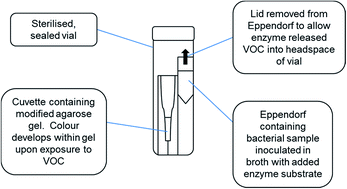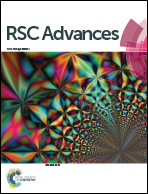Analysis of pathogenic bacteria using exogenous volatile organic compound metabolites and optical sensor detection†
Abstract
A novel, low-cost and simple method for the detection of pathogenic bacteria is proposed. The approach is based on the generation of an exogenous volatile organic compound (VOC) produced by the addition of an enzyme substrate to the bacterial sample. The generated VOC is then trapped in agarose gel allowing colour development to take place; visual detection is then possible by both the naked eye and by colorimetric analysis. Agarose gel has been evaluated as both a suitable VOC trapping matrix and host for the colour-generating reagents. This proof of concept method allowed for the discrimination between β-glucosidase and β-alanyl aminopeptidase producing bacteria. Enterococcus faecium and Klebsiella pneumoniae are both β-glucosidase producers and generated a yellow colour within agarose gels upon enzymatic hydrolysis of 2-nitrophenyl-β-D-glucoside. Pseudomonas aeruginosa is a known β-alanyl aminopeptidase producer and was shown to hydrolyse the trifluoroacetic acid (TFA) salt of 3-amino-N-phenylpropanamide resulting in the development of an orange colour within agarose gels spiked with the sodium salt of 1,2-naphthoquinone-4-sulfonic acid. 3-Amino-N-phenylpropanamide (as its TFA salt) and 2-nitrophenyl-β-D-glucoside concentrations of 20 μg mL−1 (or 72 μmol L−1) and 100 μg mL−1 (or 332 μmol L−1), respectively were the minimum quantities required for colour production following 18 h of incubation. The use of 3-amino-N-phenylpropanamide, TFA salt indicated that synthesised enzyme substrates can be tailor-made to liberate exogenous VOCs for colour generation.


 Please wait while we load your content...
Please wait while we load your content...